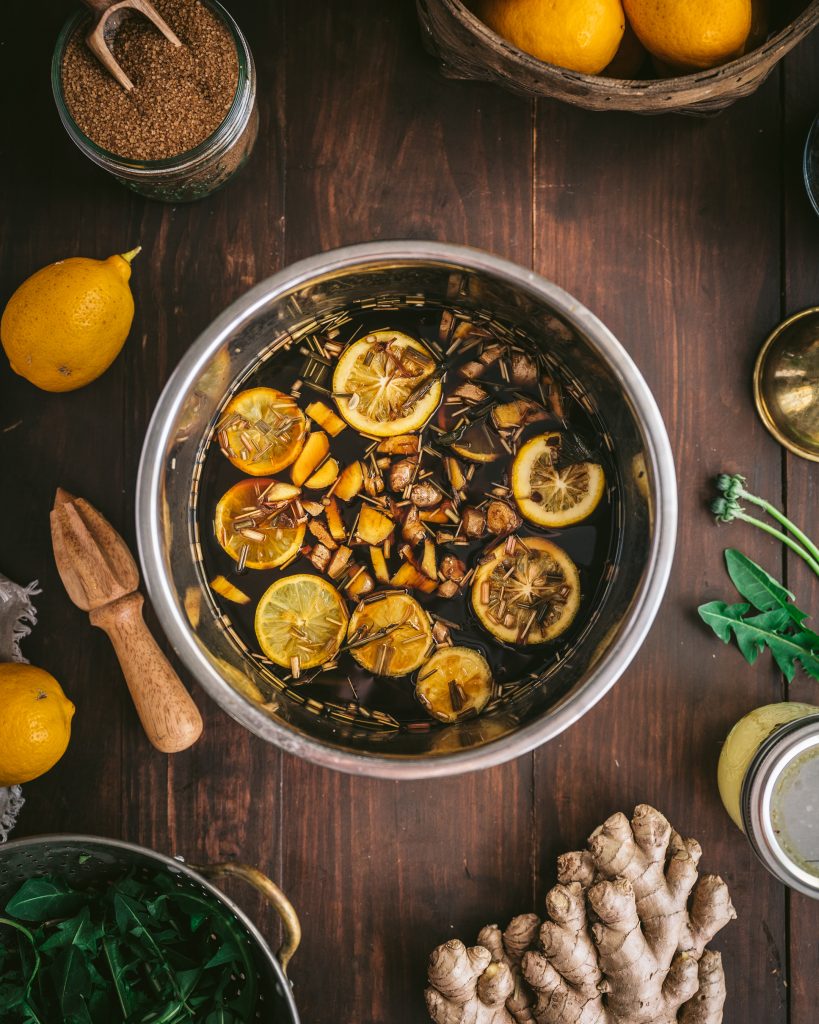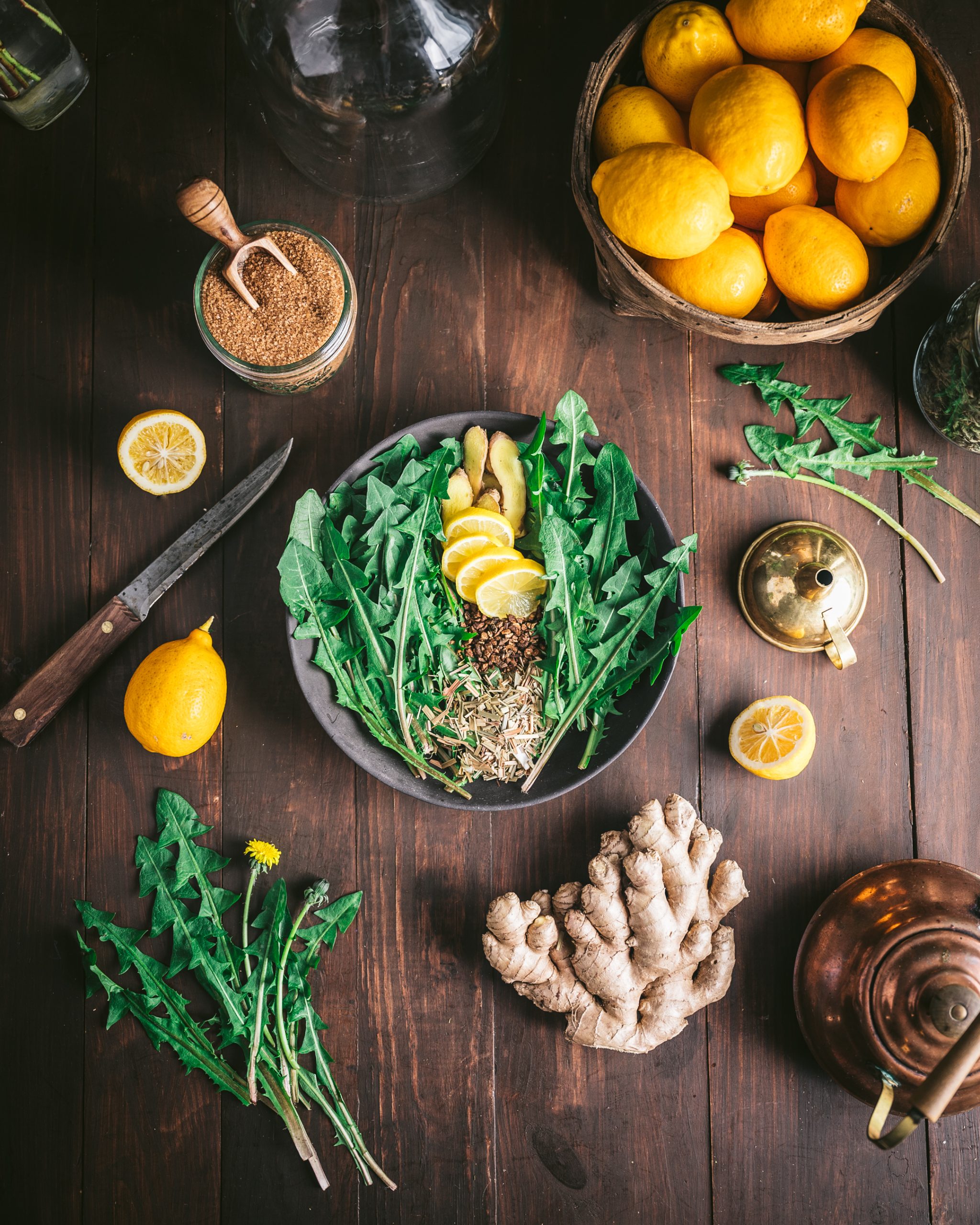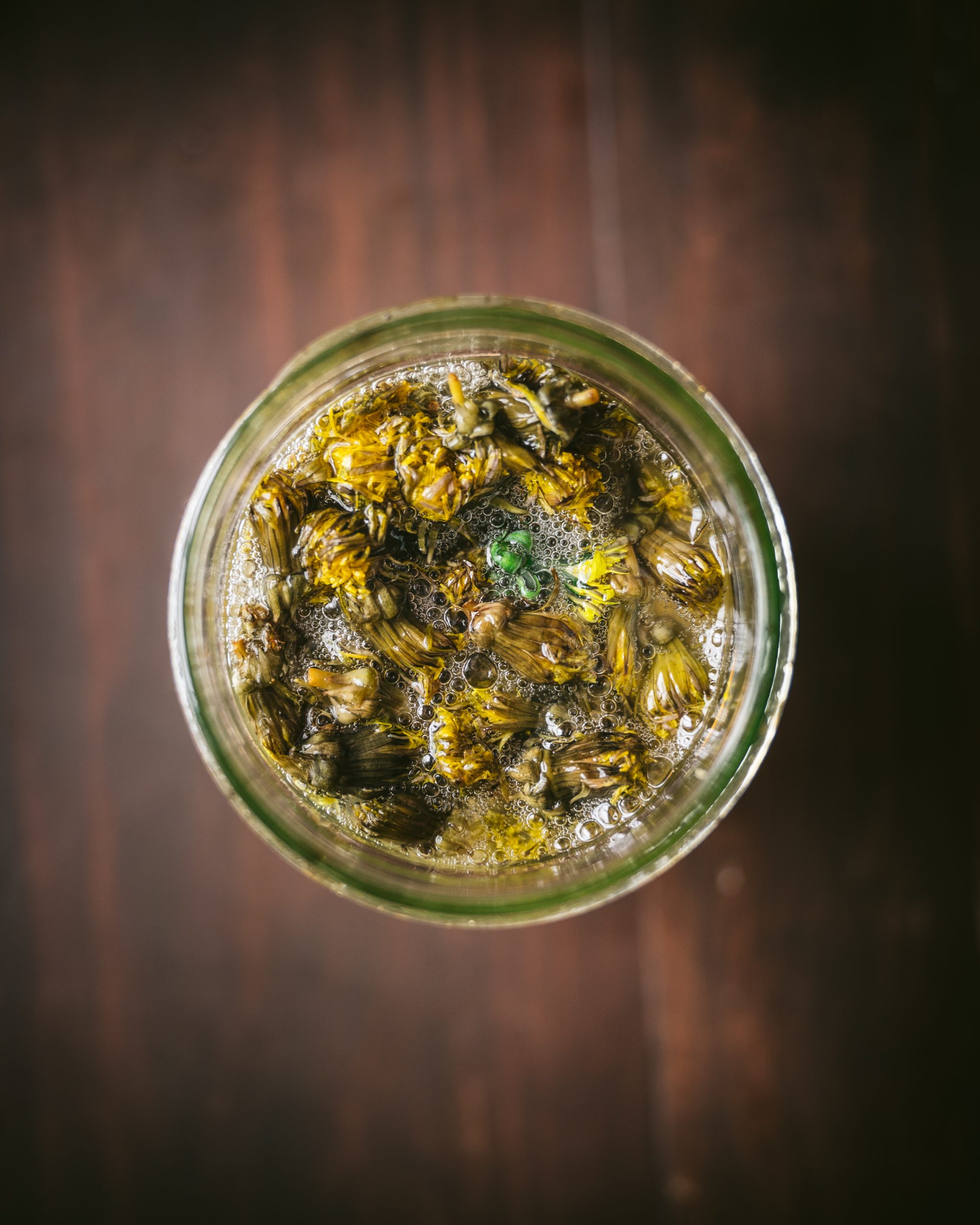Dandelion beer is a light spring beer that’s a good blend of tart and bitter with an earthy, mineral finish. Since dandelion greens are bitter, it gives herbal “beers” a bitter taste very much like the real thing, only with added health benefits! Dandelions are loaded with vitamin C and beta-carotene, making this drink a health tonic that not only tastes good, but is also good for you.

Is Dandelion Beer a Real Beer?
The answer is technically, no. According to the accepted definition of beer, it must contain hops, and use malted grains as the sugar source. Miriam-Webster defines beer as:
a carbonated, fermented alcoholic beverage that is usually made from malted cereal grain (especially barley), is flavored with hops, and typically contains less than a 5% alcohol content
However, as an herbalist and forager, I tend to prefer the second definition of what constitutes a beer:
a carbonated nonalcoholic or a fermented slightly alcoholic beverage with flavoring from roots or other plant parts
Whatever you want to call it, using hops exclusively as the bittering and flavoring agent is relatively new in brewing. There are numerous bitter herbs, such as dandelion, that can provide that bitter flavor, though hops is definitely a good one.

What Does Dandelion Beer Taste Like?
Dandelion beer has a good balance of bitter, tart, and sweet. Providing you bottle it before all the sugar is consumed by the yeast, this is a refreshing tonic beverage with a low alcohol content.
I’m not one to go for the IPA level beers myself, but I found this one to be a good balance of bitter and tart. I would equal the bitterness level of dandelion beer to a low level IPA.
This herbal beer is great for anyone who enjoys a stout brew with a decent amount of bitterness. With the brown sugar and molasses, it truly tastes like a real beer.
Why Use Dandelions?
Most people think of dandelion (Taraxacum officinale) as an invasive weed and fight a continual battle to eradicate it from their lawn. But the plant has long been used in herbal medicine to help with digestion and stimulate the appetite.
Dandelions have a long history of use in brewing medicinal beers, similar to nettle beer. For those interested in brewing craft beers with foraged ingredients and wild foods, dandelion beer is a throwback to a rustic beer folks would have made in the absence of hops.
You can safely eat the entire dandelion plant from root to blossom. It tastes bitter and chicory-like, hence the popularity of dandelion root as a coffee substitute. The flowers are a great source of wild yeast, and can be cultivated to make wild yeast starters (what I used in this recipe).
How Much Alcohol is in Dandelion Beer?
The goal of this herbal beer is to enjoy the medicinal benefits of dandelions. However, since this is a fermented beverage, it does contain some alcohol. However, I don’t currently have a hydrometer to measure the alcohol level, so I can’t tell you exactly how much.
Based on the taste and feeling after consuming this herbal beer, I would guess the alcohol level is somewhere around 4 to 5%. This is variable based on how much sugar is added and the length of time you ferment it.
Since I use wild yeast starters to make my beers, this helps keep the alcohol level lower, because wild yeasts typically die when exposed to alcohol levels higher than 5 to 6%.

What Are The Health Benefits Of Dandelions?
From root to flower, dandelions are edible and highly nutritious plants loaded with vitamins, minerals, and fiber. They are loaded with antioxidants and are rich in vitamin A and C.
These sunny weeds have been used for centuries in traditional medicine all over the world as a restorative tonic, edible food, and in wildcrated beers and wines.
As a tonic herb, dandelion supports digestive and gastrointestinal health, stimulates the appetite and tones the digestive system.
Dandelion root is a bitter digestive tonic used to detoxify the liver and gallbladder, stimulate the apptetite, and tone the digestive system.
The leaves have mild diuretic properties which support kidney funtion and can be eaten raw as a wild green in spring. The edible flowers contain antioxidants and are great source of wild yeast.

Dandelion Beer Ingredients
I will list the main ingredients I use to make this beer, and why I added them. Keep in mind that dandelion beer can be made with different ingredients available seasonally based on what you are foraging and growing.
Dandelion greens — This beer is best made with young dandelion greens in the spring. Dandelion leaves will get tougher and very bitter later in the season, especially if there is little rain. You can usually find dandelions growing in your own yard or just about anywhere. Though you want to make sure they are not sprayed!
Dandelion roots — Roasted dandelion roots add a delicious roasted nutty flavor to the beer. The roots can be harvested in fall by digging them up from the ground. Be warned though, this is quite a workout as dandelions have a long taproot! You can purchase the roots from most health food stores too.
Brown sugar or molasses — Using brown sugar or molasses results in a beverage that has a “beer” like taste. I typically use both brown sugar and a small amount of molasses, to develop depth and flavor. If you use cane sugar or white sugar, the resulting beverage will taste more like cider.
Ginger — This adds a spicy, gingery taste to the beer and helps balance the bitterness.
Lemons — Lemons add a citrus taste to the beverage. I add 3 lemons, including the peels, as I love a citrusy beer to counteract the bitterness of the dandelions.
Lemongrass — Fresh or dried lemongrass can be added instead of lemons. Dried lemongrass can overpower the beer with an overwhelming sour taste, so only add about 1/4 oz of dried herb.
Dried nettles — Nettles are an entirely optional addition. I foraged a large amount of nettles from up in the mountains last summer, and I am adding them to most of my teas and beverages to use them up. That being said, nettles add an earthy, mineral taste to the beer that’s quite good.
Yeast — Either wild yeast from a starter you keep on hand, such as a ginger bug, or commercial beer yeast. I only have experience brewing herbal beers with wild yeast myself.
Cream of tartar— This helps keep the sugar from crystalizing, and adds acidity.


Dandelion Beer
Dandelion beer is a light spring beer that’s a good blend of tart and bitter with an earthy, mineral finish. Since dandelion greens are bitter, it gives herbal “beers” a bitter taste very much like the real thing, only with added health benefits!
Ingredients
- 1 gallon (3.78 L) water
- 1/2 lb. dandelion greens (2 large handfuls)
- 1/2 oz. roasted dandelion roots
- 1 lb. (16 oz) brown sugar
- 1/2 oz. fresh ginger, chopped
- 3 lemons, juiced
- 1/2 oz. dried nettles (optional)
- 1 oz. cream of tartar
- Yeast (I use 1 cup wild yeast starter)
- 1/4 oz. dried lemon grass
Instructions
- In a large pot, bring 1/2 gallon of water to boil. Add the dandelion greens, lemongrass, and dried dandelion roots. Simmer gently for 20 min.
- Turn off heat. Add the ginger, dried nettles, lemon juice and rinds, cream of tartar, and sugar. Mix well to dissolve the brown sugar using a spoon.
- Steep the tea for 30 minutes or more, keeping pot covered to prevent contamination with dust.
- Strain out herbs, and pour the tea into a clean carboy. Add remaining half gallon of water. Allow the beer to cool to room temperature (70° F/21° C) before adding the yeast.
- Once cooled, add the yeast and mix it well by swirling the jar. Cover the jar with an airlock and ferment for 7 days or until the beer stops bubbling.
- Bottle the beer into swing-top bottles. Another option is to use recycled soda bottles so you can squeeze them to monitor the carbonation build-up. This is easiest done with an auto-siphon, or use a funnel and carefully pour into each bottle, leaving behind the cloudy layer of sediment at the bottom.
- Let the bottled beer sit at room temperature for another 1 to 2 days to carbonate, then refrigerate. This slows down the fermenation. Dandelion beer is best enjoyed young.
- Be sure to monitor the pressure and burp every day to release excess pressure. In a couple days you should have a nice level of carbonation.
Notes
The beer will ferment faster in warmer temperatures. Keep in mind this is an active fermentation, and can build pressure quickly during the fermentation process. After bottling the beer, be sure to check for excess pressure to avoid explosions.
For a darker beer, add a small amount of blackstrap molasses in addition to brown sugar. Reduce the amount a sugar slightly if adding molasses.
No Comments